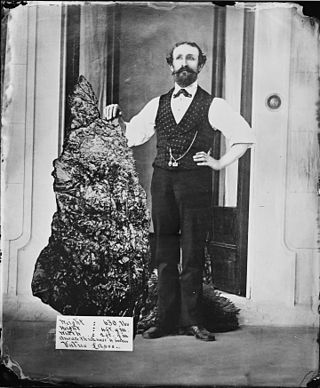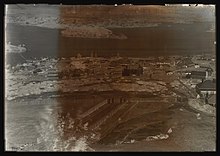
A photograph is an image created by light falling on a photosensitive surface, usually photographic film or an electronic image sensor, such as a CCD or a CMOS chip. Most photographs are now created using a smartphone/camera, which uses a lens to focus the scene's visible wavelengths of light into a reproduction of what the human eye would see. The process and practice of creating such images is called photography.

The collodion process is an early photographic process. The collodion process, mostly synonymous with the "collodion wet plate process", requires the photographic material to be coated, sensitized, exposed, and developed within the span of about fifteen minutes, necessitating a portable darkroom for use in the field. Collodion is normally used in its wet form, but it can also be used in dry form, at the cost of greatly increased exposure time. The increased exposure time made the dry form unsuitable for the usual portraiture work of most professional photographers of the 19th century. The use of the dry form was therefore mostly confined to landscape photography and other special applications where minutes-long exposure times were tolerable.

Photographic plates preceded photographic film as a capture medium in photography, and were still used in some communities up until the late 20th century. The light-sensitive emulsion of silver salts was coated on a glass plate, typically thinner than common window glass.
Panoramic photography is a technique of photography, using specialized equipment or software, that captures images with horizontally elongated fields of view. It is sometimes known as wide format photography. The term has also been applied to a photograph that is cropped to a relatively wide aspect ratio, like the familiar letterbox format in wide-screen video.

The albumen print, also called albumen silver print, was published in January 1847 by Louis Désiré Blanquart-Evrard, and was the first commercially exploitable method of producing a photographic print on a paper base from a negative. It used the albumen found in egg whites to bind the photographic chemicals to the paper and became the dominant form of photographic positives from 1855 to the start of the 20th century, with a peak in the 1860–90 period. During the mid-19th century, the carte de visite became one of the more popular uses of the albumen method. In the 19th century, E. & H. T. Anthony & Company were the largest makers and distributors of albumen photographic prints and paper in the United States.

Gulgong is a 19th-century gold rush town in the Central Tablelands and the wider Central West regions of the Australian state of New South Wales. The town is situated within the Mid-Western Regional Council local government area. It is located about 300 km (190 mi) north west of Sydney, and about 30 km north of Mudgee along the Castlereagh Highway. At the 2016 Census, Gulgong had a population of 2,521.

The State Library of New South Wales, part of which is known as the Mitchell Library, is a large heritage-listed special collections, reference and research library open to the public and is one of the oldest libraries in Australia. Established in 1869 its collections date back to the Australian Subscription Library established in the colony of New South Wales in 1826. The library is located on the corner of Macquarie Street and Shakespeare Place, in the Sydney central business district adjacent to the Domain and the Royal Botanic Gardens, in the City of Sydney. The library is a member of the National and State Libraries Australia (NSLA) consortium.

Richard Daintree CMG was a pioneering Australian geologist and photographer. In particular, Daintree was the first Government geologist for North Queensland discovering gold fields and coal seams for future exploitation. Daintree was a pioneer in the use of photography during field trips and his photographs formed the basis of Queensland's contribution to the Exhibition of Arts and Industry in 1871. Following the success of the display, he was appointed as Queensland's Agent-General in London in 1872 but was forced to resign in 1876 due to ill-health and malpractice by some of his staff although not Daintree himself. A number of features in North Queensland have been named after Daintree including the town of Daintree, Queensland, the Daintree National Park, the Daintree River, the Daintree Rainforest which has been nominated for the World Heritage List and the Daintree Reef.

Maxwell Spencer Dupain AC OBE was an Australian modernist photographer.
The conservation and restoration of photographs is the study of the physical care and treatment of photographic materials. It covers both efforts undertaken by photograph conservators, librarians, archivists, and museum curators who manage photograph collections at a variety of cultural heritage institutions, as well as steps taken to preserve collections of personal and family photographs. It is an umbrella term that includes both preventative preservation activities such as environmental control and conservation techniques that involve treating individual items. Both preservation and conservation require an in-depth understanding of how photographs are made, and the causes and prevention of deterioration. Conservator-restorers use this knowledge to treat photographic materials, stabilizing them from further deterioration, and sometimes restoring them for aesthetic purposes.

Bernhardt Otto Holtermann was a successful gold miner, businessman, politician and photographer in Australia. Perhaps his greatest claim to fame is his association with the Holtermann Nugget, the largest gold specimen ever found, 59 inches (1.5 m) long, weighing 630 pounds (290 kg) and with an estimated gold content of 3,000 troy ounces (93 kg), found at Hill End, near Bathurst, New South Wales. This gave him the wealth to build a mansion in North Sydney, which is now one of the boarding houses at Sydney Church of England Grammar School.
New South Wales experienced the first gold rush in Australia, a period generally accepted to lie between 1851 and 1880. This period in the history of New South Wales resulted in a rapid growth in the population and significant boost to the economy of the colony of New South Wales. The California Gold Rush three years prior signaled the impacts on society that gold fever would produce, both positive and negative. The New South Wales colonial government concealed the early discoveries, but various factors changed the policy.

Charles Bayliss, photographer, was born in Hadleigh, Suffolk, England in 1850. He went to Australia with his parents and they arrived in Melbourne in 1854.

Henry Beaufoy Merlin (1830–1873) was an Australian photographer, showman, illusionist and illustrator. In the 1850s he worked as a theatrical showman and performer in Sydney, Newcastle and Maitland. In 1863 he was the first person to introduce Pepper's ghost to Australia. After this, he took up photography and between 1869 and 1872 turned the American Australasian Photographic Company into one of the most respected studios in Australia. Between 1872 and 1873 he worked extensively documenting the goldfields and mining towns of New South Wales. In 1873, as an employee of Bernhardt Holtermann, he photographed Sydney and many rural New South Wales towns. He died on 27 September 1873.

Eric Keast Burke was a New Zealand-born Australian photographer and journalist.

Gulgong Holtermann Museum is a community project and a museum space located in gold rush town of Gulgong, New South Wales. Two of the town's earliest buildings, also featured on Australian ten-dollar note renovated and extended, house an interactive educational and tourist facility based on the UNESCO listed Holtermann Collection - photographs taken for Bernhardt Holtermann during the "roaring days" in the 1870s.

The Australasian Photo-Review was an English language magazine, published for photographers by Baker & Rouse and later Kodak (Australasia), and published in Sydney, Australia 1894–1956.

The Greatest Wonder of the World and American Tobacco Warehouse and Fancy Goods Emporium are heritage-listed adjacent shops at 123-125 Mayne Street, Gulgong, Mid-Western Regional Council, New South Wales, Australia. They were built from 1870 to 1878. They have been refurbished to house the Gulgong Holtermann Museum, with new galleries constructed at the back to house the UNESCO listed HOLTERMANN COLLECTION. The original buildings were added to the New South Wales State Heritage Register on 21 October 2016.
Louisa Elizabeth How (1821–1893) was the first woman photographer in Australia whose works survive.

John Moran was a pioneering American photographer and artist. Moran was a prominent landscape, architectural, astronomical and expedition photographer whose career began in the Philadelphia, Pennsylvania area during the 1860s.

















